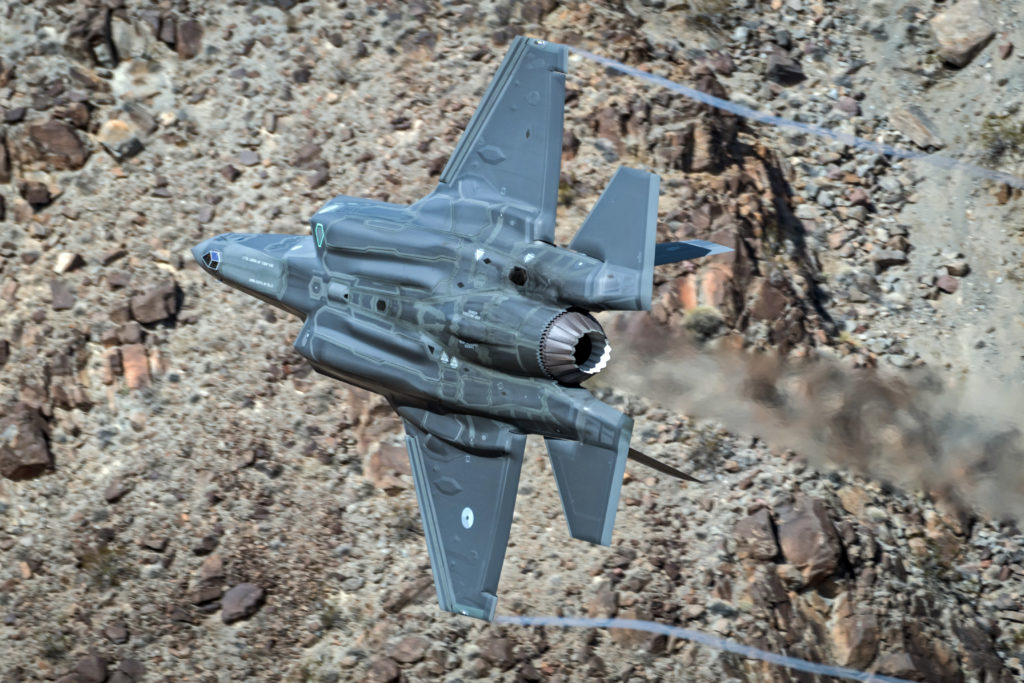Estimated reading time 7 minutes, 41 seconds.
The F-35A Lightning II Joint Strike Fighter might be the youngest fighter aircraft in the competition to replace the Royal Canadian Air Force (RCAF) fleet of CF-188 Hornets, but manufacturer Lockheed Martin insists it is a mature plane.

In a background briefing to Canadian media on July 30, officials with the company highlighted the F-35’s fifth-generation capabilities, longer-term modernization program, and industrial opportunities for Canadian suppliers as it prepares its response to the government’s request for proposals (RFP), released on July 23.
But officials were keen to dispel any lingering myth that the F-35 is still an expensive and unproven fighter.
Though production of the Joint Strike Fighter is still ramping up, over 400 jets have been produced and seven services have declared initial operating capability, including the United States Air Force, Navy, and Marine Corps and Royal Air Force. Ninety-one aircraft were delivered in 2018 and 135 more are expected to be in the hands of customers in 2019.
Lockheed Martin anticipates over 860 F-35 variants will be operating from almost 30 bases by 2022, the timeframe Canada is expected to reach a decision and award a contract for 88 fighters to replace the Hornets.
Increasingly, the F-35 is being deployed on operations. United Kingdom F-35B Lightning aircraft conducted their first missions over Syria and Iraq during a deployment to Cyprus in May and June, and the U.S. Air Force confirmed two aircraft struck an ISIS tunnel network and weapons cache in Iraq on April 30.
It’s unclear whether the fighter has been deployed yet in a NORAD response, one of the primary missions of the RCAF fleet and an integral part of both Canadian and U.S. defence.
As more aircraft have entered service, the costs per aircraft and per flight hour have dropped. Lockheed Martin officials highlighted a 60 per cent reduction in the unit fly away cost from LRIP 2 (Low Rate Initial Production) in 2008 to LRIP 10 in 2016, and emphasized a further reduction of about 15 per cent over the next few years as the company strives to drive the unit cost well below US$80 million, a target it set with the U.S. government and is expected to reach with LRIP 13 this year.

It’s also aiming for a cost of US$25,000 per flight hour by 2025, a reduction of almost $10,000 from the current rate of what officials said was in the mid $30,000s.
As acquisition costs decline, Lockheed Martin is now “also going to focus on the operation and sustainment of the planes over time,” said an official, by increasing the mission capable rate to 80 per cent through improvements to maintenance systems and supply availability.
While cost will be a significant factor in Canada’s assessment of the fighters — 20 per cent of the evaluation — capability will account for 60 per cent. And here, Lockheed Martin believes it has the most advanced and capable aircraft.
“We believe [the F-35] truly is the most advanced fighter on the planet,” said one official during the briefing.
In addition to very low observable stealth, a feature the company has repeatedly insisted must be designed in from beginning, not managed after the fact through a reduction in the aircraft’s signature, the F-35 features a fusion of sensor capability and situational awareness “that is simply unparalleled.”
It can carry up to 18,000 pounds of ordnance to meet its core missions of strategic attack, close air support, suppression/destruction of enemy air defence, and air superiority, and also features an electronic warfare suite of capabilities that remain largely classified.
Lockheed Martin is also proposing a modernization program of upgrades, some of which could be available for a Canadian variant, including an automatic ground collision avoidance system, external fuel tanks to extend the range of the fighter, and increased weapons capacity in the weapons bay that would allow the aircraft to carry six rather than four missiles internally.
Other block upgrades could include integration of new weapons, including hypersonic missiles, enhancements to the open system architecture which would further enhance situational awareness, among other things, and the ability to team with and command unmanned aircraft.
“Countries like Canada can buy a fifth-generation airplane, and the capability that comes with that, at or about or below the same unit costs as a fourth-generation airplane, and then operate and sustain it for again about the same costs as a fourth-generation airplane,” said an official. “We think that puts us in a favourable position in Canada’s competition.”
Lockheed Martin is also hoping the government will see the value of a 3,000 to 4,000 aircraft production run as it assesses the economic benefit of the F-35 to Canada. Under the rules of the F-35 partnership agreement, Lockheed Martin cannot offer traditional offsets to potential customers, what Canada calls industrial and technological benefits (ITBs). But its “best value” approach for components means suppliers provide parts for the entire global fleet, not just the aircraft being manufactured and supported by their own country.
At present, 71 Canadian first and second tier companies, from Magellan Aerospace to Héroux-Devtek, Stelia Aerospace and Honeywell, are providing components to the program. Lockheed Martin officials noted the real enduring opportunities could come in sustaining the global fleet.
“Canada is well positioned because it is co-located with the biggest fleet of F-35s in North America. As we build up sustainment capability in Canada to sustain your aircraft, that will inherently be an opportunity to support the F-35s in North America collectively,” said one official.
That could include establishing a Canadian supplier as the focal point for maintenance, much in the way Lockheed Martin has named Cascade Aerospace, part of the IMP Group, as a global C-130J heavy maintenance centre.
“We’ll definitely have a sustainment integration task inside Canada that can bring best value to the RCAF,” said the official.









Ask Turkey how JSF treats its partners…